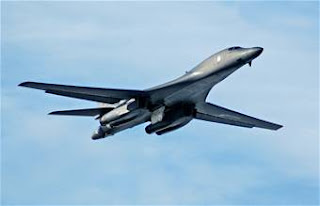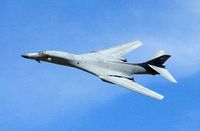B-1B LANCER: Mission - Carrying the largest payload of both guided and unguided weapons in the Air Force inventory, the multi-mission B-1 is the backbone of America's long-range bomber force. It can rapidly deliver massive quantities of precision and non-precision weapons against any adversary, anywhere in the world, at any time.
Features - The B-1B's blended wing/body configuration, variable-geometry wings and turbofan afterburning engines, combine to provide long range, maneuverability and high speed while enhancing survivability. Forward wing settings are used for takeoff, landings, air refueling and in some high-altitude weapons employment scenarios. Aft wing sweep settings – the main combat configuration -- are typically used during high subsonic and supersonic flight, enhancing the B-1B's maneuverability in the low- and high-altitude regimes.
The B-1B's speed and superior handling characteristics allow it to seamlessly integrate in mixed force packages. These capabilities, when combined with its substantial payload, excellent radar targeting system, long loiter time and survivability, make the B-1B a key element of any joint/composite strike force. The B-1 weapon system is capable of creating a multitude of far-reaching effects across the battlefield.
The B-1 is a highly versatile, multi-mission weapon system. The B-1B's offensive avionics system includes high-resolution synthetic aperture radar, capable of tracking, targeting and engaging moving vehicles as well as self-targeting and terrain-following modes. In addition, an extremely accurate Global Positioning System-aided Inertial Navigation System enable aircrews to autonomously navigate globally, without the aid of ground-based navigation aids as well as engage targets with a high level of precision.
Photo, Text Disclaimer:
1. Air Force Link is provided as a public service by the Office of the Secretary of Air Force (Public Affairs).
2. Information presented on Air Force Link is considered public information and may be distributed or copied. Use of appropriate byline/photo/image credits is requested.
Generally speaking, works created by U.S. Government employees are not eligible for copyright protection in the United States. See Circular 1 "COPYRIGHT BASICS" from the U.S. Copyright Office.
The recent addition of Combat Track II radios permit an interim secure beyond line of sight reach back connectivity until Link-16 is integrated on the aircraft. In a time sensitive targeting environment, the aircrew can receive targeting data from the Combined Air Operations Center over CT II, then update mission data in the offensive avionics system to strike emerging targets rapidly and efficiently. This capability was effectively demonstrated during operations Enduring Freedom and Iraqi Freedom.
Related: Public Domain Clip Art Archive June - July 2005 and Aircraft
Nanotechnology Today or Public Domain Clip Art and Republican National Convention Blog

















No comments:
Post a Comment